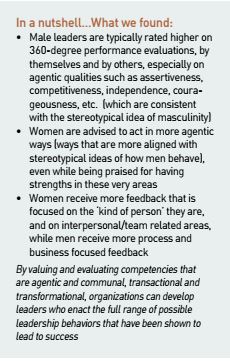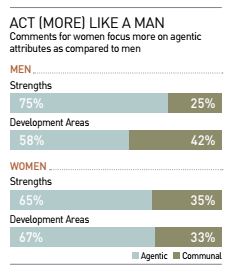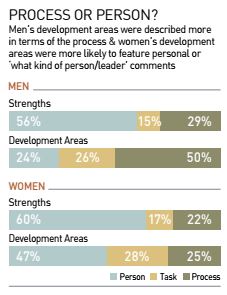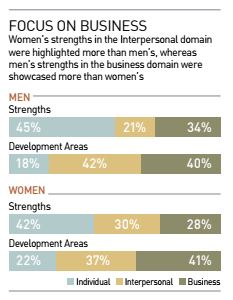360 Degrees of Grey: The Impact of Gendered Feedback

Performance management is the process of communicating job expectations to employees, engaging employees in goals-setting and coaching conversations, evaluating employee performance, and making talent management decisions related to compensation, placement, and development. One popular input to performance management and talent development is the use of multisource feedback (often called 360-degree feedback), where employees are rated on their performance by managers, peers, direct reports and even customers; and although this has several advantages, it carries its share of risks and pitfalls.
Many managers may be surprised to learn that men and women are evaluated differently for performance reviews, and the cumulative impact of these differences can affect the overall business performance.
Susan Colantuno, in her recent TED Talks, talked about the three elements of leadership success that help propel careers i.e. personal greatness, engaging the greatness of others, and achieving & sustaining extraordinary outcomes. Career advice given to women emphasize on the ability to be confident, creating a personal brand, negotiating, building communications skills, speaking up and engaging teams; however, it misses out the third element of leadership success i.e. the business, strategic and financial acumen required to be leaders.
Research suggests that women and men are assessed differently at work
- Women leaders are judged better at caretaking leader behaviors and men at take charge behaviors.1
- Women are just as likely to ask for feedback as their male colleagues but are less likely to get it.2
- Women get fewer, high visibility roles and experiences or hot jobs which cause gender gaps at senior levels.3
Women receive less helpful feedback than men
- Men received developmental feedback linked to business outcomes while women received feedback related to their personality rather than performance.4
- Women are less likely to receive constructive feedback and specific feedback tied to outcomes.5
- Women’s receive more critical feedback and less constructive suggestions.6
- Women were 1.4 times more likely to receive critical subjective feedback as opposed to either positive feedback or critical objective feedback.7

The differences in how male and female employees have evaluated matters because performance is evaluated against standards that are linked to the business strategy. However, often, definitions of leadership and performance in organizations are gendered, and tend to be more masculine or consistent with male stereotypes.8
Women usually get caught between two unpalatable options: to act in stereotypically feminine ways and risk not being taken seriously as a leader, or to act in more masculine ways and being seen as not ladylike. This is the classic Double Bind dilemma12 and is also related to the Think Manager Think Male phenomenon which establishes this greater overlap between masculine attributes and leadership attributes than between feminine attributes and leadership attributes.9
Paying attention to gendered performance management matters because notions of work and leadership are also expanding. The agentic-versus-communali characteristic distinction applies here and parallels the transactional-transformational leadership styles distinction10 that has been well established by research. In fact, research shows that transformational leadership behaviors have much greater impact on outcomes as varied as employee satisfaction and firm performance11, compared to transactional behaviors. Taking that argument further, if transformational (and communal) styles are beneficial, it stands to reason that leaders should be provided balanced feedback that replaces the prior focus on transactional (and agentic) behaviors.
Does India Inc. prey victim to the same patterns?

In the face of all this, we set out to answer a few broad questions:
1. How do these patterns manifest similarly or differently in India?
2. If so, do these differences emerge in both numerical and narrative feedback?
3. What does this mean for the career growth of people from all genders?
In order to answer these questions, YSC India looked at the developmental feedback of mid to senior leaders in 15 organizations in different industries in India. Overall, men tended to have more raters and received more feedback than women, which highlights the gap in terms of exposure to feedback. Yet women received more feedback in their development areas vs. strengths in comparison to their male counterparts. Women were also given more objective narrative feedback on their development areas with detail observations and examples in comparison to their strengths which were more subjective or vague.
Men rated themselves higher than women on competencies like Commercial Mindset, Strategic Focus, Developing High-Performance Team, Performance Mindset and Authentic Engagement which are more agentic in nature. Agentic qualities are associated more with masculine behaviors that convey assertion and control which are also synonymous with the traditional definition of effective leadership. Not surprisingly, we saw that men were rated higher by others on competencies like Adaptive Thinking & Problem Solving and Strategic Focus which are arguably more agentic. There were fewer significant differences in competencies like Flexible Influencing Styles and Developing Others which are more communal qualities that include consensus building, collaborating and fostering growth.

We saw that a majority (2/3rd) of the comments on strengths provided to women emphasized traits like self-advancement, independence, assertiveness, and decisiveness whereas only 1/3rd emphasized traits like developing others, collaboration, etc. This changed across development areas where comments for women focused.
A similar pattern emerged when we looked at the comments in terms of their Focus. Men’s development areas were described more in terms of the process or ‘how’ they got work done compared to women’s (50% versus 29%). Women’s development areas were more likely to feature personal or ‘what kind of person/leader’ comments (56% versus 24%).
There were no significant differences across the three areas. However, women’s strengths in the Interpersonal domain were highlighted more than men’s (30% versus 21%). Men’s strengths in the Business domain were showcased more than women’s (34% versus 28%).
What can organizations and leaders do to ensure more balanced and helpful feedback for all leaders?

The feedback given to women – a critical element in their development journeys – is biased in predictably stereotypical ways and holds women back. Organizations and organizational leaders, regardless of gender can benefit from more balanced leadership, focused on tapping into the full spectrum of leadership behaviors that is important for success.
What should organizations start doing?
- Track developmental feedback and opportunities by gender to identify potential gaps (in units, managers, functions).
- Train managers to ensure that feedback given to all employees is balanced i.e. focused on both, the relationship and business/task aspects of work.
- Ensure that men are receiving enough feedback on the communal and transformational aspects of leadership and not just the agentic.
- Review the language used in performance management including competency models to avoid gendered language
What should organizations stop doing?
- Think Manager, Think Male: Define leadership, competence and performance in gendered (masculine) terms
- Assume that the annual performance reviews will automatically result in employee development
- Focusing performance appraisal training only on the mechanics (e.g. rating scales) but ignoring the importance of a feedback culture
What should organizations continue doing?
- Use multisource (360 degree) reviews as a powerful feedback/employee development tool, distinct from performance appraisal that results in pay/promotion decisions.
- Integrate feedback and coaching into larger strategic HR and talent management initiatives, and ensure access to women and men in proportional terms.
What can you do?
- Create objective criteria and provide support or exposure needed for optimal performance.
- Examine carefully the words you use in your performance feedback – Are they gender neutral?
- Check if your feedback is helpful and specific – substantiate it with examples?
- Observe the employee and value the person’s behavior in different contexts.
- Constantly check whether your feedback is affected by gender role expectations – Ask yourself if you would say this to someone of the opposite gender if they behaved this way?
- Agentic qualities are those that emphasize self-advancement, independence, assertiveness, control and decisiveness (such as determined, dominant, competitive). In contrast, communal attributes are nurturing traits that emphasize maintenance of social relationships, social activities like consensus building, developing others and collaboration (such as warm, helpful, cooperative).
- Insights from narrative feedback indicates trends and patterns but not statistically significant differences.
References
1 Catalyst, Inc. (2005). Women "Take Care," Men "Take Charge
2 Lean In & McKinsey (2016). Women in the Workplace
3 Catalyst Inc. (2012). Good Intentions, Imperfect Execution? Women Get Fewer Of The “Hot Jobs” Needed To Advance
4 Silverman, R. E. (2015). Gender Bias at Work Turns Up in Feedback. Wall Street Journal, 1–5.
5 Correll, S., & Simard, C. (2016). Research: Vague Feedback Is Holding Women Back. Harvard Business Review
6 Snyder, K. (2014). The abrasiveness trap: High-achieving men and women are described differently in reviews. Fortune
7 Cecchi-Dimeglio, P. (2017). How Gender Bias Corrupts Performance Reviews, and What to Do About It. Harvard Business Review.
8 Koenig, A. M., Eagly, A. H., Mitchell, A. A., & Ristikari, T. (2011). Are leader stereotypes masculine? A meta-analysis of three research paradigms. Psychological Bulletin, 137(4), 616-642.
9 Schein, V. E., & Davidson, M. J. (1993). Think manager, think male. Management Development Review, 6(3), 24.
11 Dumdum, U. R., Lowe, K. B., & Avolio, B. J. (2013). A meta-analysis of transformational and transactional leadership correlates of effectiveness and satisfaction: An update and extension. In Transformational and Charismatic Leadership: The Road Ahead 10th Anniversary Edition (pp. 39-70). Emerald Group Publishing Limited.
12 Catalyst, Inc. (2007). The double-bind dilemma for women in leadership: Damned if you do, doomed if you don't.















